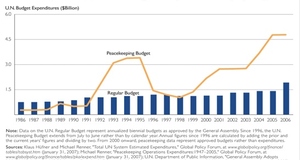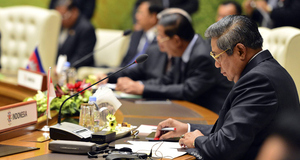Student VoicesThe Equivocal Nature of Exploitation: How Poor Workers in Developing Nations Exploit Capitalist Greed for a Profit
By
2010, Vol. 2 No. 11 | pg. 1/1
KEYWORDS:
Learning to play guitar is painful. For the first months, the coarse steel of the guitar strings shreds the soft skin of the player’s fingertips into a disgusting bloody mess. A reasonable person who does not play guitar would be entirely justified in thinking that the guitar student ought to take it a little bit easier on his poor fingers. Nonetheless, if the guitar student wants to some day be able to play without the pain, his best move is to play as much as possible. In the developing world, sweatshop labour might be viewed in a similar light as the mutilated fingertips of the guitar player. If that analogy sounds callous, it is meant to be the opposite. Consider that Nicolas Kristoff, a Pulitzer Prize winning journalist and champion of human rights in the developing world, recently wrote from a Cambodian slum that "the central challenge in the poorest countries is not that sweatshops exploit too many people, but that they don’t exploit enough". Similarly, economist Jeffrey Sachs recently expressed that his "concern is not that there are too many sweatshops but that there are too few" (Myerson). The apparent pro-sweatshop stance might seem outrageous, but it has high-profile supporters. These supporters cite a large body of economic theory, empirical evidence, and history that substantiates the thesis that so-called “sweatshop labour” is an inevitable developmental phase for any society, and is actually self-correcting (much like the torn up fingers of the developing guitarist). A movement to boycott imports from nations where these conditions are common will only decelerate the natural process that has successfully made First World nations prosperous. Like confiscating the guitar to save the fingertips from their ugly developmental phase, such a movement would sacrifice the realization of an important overarching goal in favor of an illusory solution to the wrong problem.Low wages are not a scourge of developing nations — they are a bargaining chip that can be leveraged into a way out of the "developing world."
There is an important reason why poor nations have taken over the manufacture of textiles and other labour-intensive industries from the developed world. In 1821, groundbreaking British economist David Ricardo proposed the theory of comparative advantage, which explains in detail what that reason is. Ricardo used a theoretical model of wine and cloth in England and Portugal to show that, in order to maximize production, "countries should do what they do best—not in comparison with other countries, but rather what they do best relative to other things they do. The comparison implied by the term [comparative advantage] compares activities within one nation (British farming and British manufacturing), not between one nation and another (British farming and Portuguese farming)" (Frieden 31). Even if one producer is more efficient than another at every single activity, Ricardo's crucial and counterintuitive insight is that by specializing in their areas of comparative advantage and trading, large efficient producers can trade with smaller less efficient ones, and both sides will be better off. A country usually has comparative advantage in an activity when it has an abundance of the elements, or factors of production, for that activity. For instance, “Canada’s comparative advantage lies in goods utilizing Canada’s technological know-how and excellent infrastructure: motor vehicles and parts (General Motors Canada, Chrysler Canada, and Ford Canada); small aircraft, engines, and locomotives (Pratt and Whitney, Bombardier); telephone equipment (Nortel); personal communication devices (Research in Motion, manufacturer of the BlackBerry device); and computer software and support (IBM Canada)” (Krugman 431). On the other hand, “clothing production is generally a labour-intensive activity: it doesn’t need much physical capital, nor does it require a lot of human capital in the form of highly educated workers. So you would expect labour-abundant countries such as China and Bangladesh to have a comparative advantage in clothing production” (432). The prediction implied by Ricardian theory is clear: developing nations with large, underutilized supplies of labour that specialize in the production of textiles and other labour-intensive activities -- and trade -- will become richer. Jeffrey Sachs, the economist who believes that there are too few sweatshops, conducted an exhaustive study of data from over 100 countries to test that prediction. He found that in the latter half of the twentieth century, poor nations who specialized and engaged in trade with richer ones have not only grown economically, but actually tended towards economic convergence: that is, they "tend[ed] to grow faster than richer countries" (Sachs et. al 35). Sachs suggests that this is uniformly true, having found "not a single country in [the] sample […] which pursued open trade policies during the entire period 1970-89 yet had per capita growth of less than 1.2 percent per year […] And not a single open developing country grew at less than 2 percent per year (Greece, at 2.38 percent, and Jordan, at 2.58 percent, are the lowest)!" (42). To understand why Sachs deems these growth rates worthy of an exclamation mark, consider that "the very large difference in living standards between the United States and Mexico is the result of the U.S. per capita GDP growing just one percentage point per year faster than Mexico over the last two centuries" (Van den Berg and Lewer 5). It's no secret that the potential to exploit low wages is what makes poor nations attractive places for multinational corporations to invest. However, poor nations with comparative advantage in the production of labour-intensive goods do not sentence themselves to an eternity of hard labour for low pay by choosing to specialize. South Korea and Taiwan, for example, "started from almost nothing in the middle 1950s, after their devastating civil wars", but only twenty years later, by specializing in low-cost labour-intensive industries and engaging in the world economy, they were "flooding world markets with toys, clothing, furniture, and other simple manufactures" (Frieden 421). As these countries developed their manufacturing sectors, "their living standards and wages rose so quickly that they became unattractive to the most labor-intensive manufacturing" (423). Less than a half-century after this process had begun, the areas of specialization had moved from simple manufactures to "sophisticated mid-market industrial products. Korean cars were a particular success: By 2000 the country produced nearly three million vehicles a year […] South Korea was also a world leader in ships, television sets, and consumer electronic equipment; Taiwan was the world's third-largest producer of computer products" (422). Low wages are not a scourge of developing nations—they are a bargaining chip that can be leveraged into a way out of the "developing world." Sometimes companies that produce labour-intensive goods in developing nations hire children; while hardly anyone in the developed world would argue in favor of this, the impoverished parents of the working children might. As unpleasant as it may be to think about, for families who are too poor to eat, a child’s income is more important than a child’s leisure or education. This phenomenon is not unique to the developing world of the present; even in Canada, it wasn’t until 100 years ago “that increases in the purchasing power of the average industrial wage afforded many working class families the 'luxury' or the opportunity of withholding their children from the labour force” (Hurl 119). It is easy to see anecdotally that as the average Canadian worker has become richer over the last hundred years, child labour has become a thing of the past. Vigorous scientific studies of child labour trends in other countries indicate that this correlation is practically universal. Vietnam, for instance, experienced phenomenal GDP increases of "nearly 9 percent per year on average" between 1993 and 1997 while at the same time "child labor […] declined by nearly 30 percent" (Edmonds 77). Economists Kaushik Basu and Pham Hoang Van explain that "children of the nonpoor seldom work even in very poor countries. This phenomenon is best explained by supposing that parents withdraw their children from the labor force as soon as they can afford to do so. In other words, children's leisure or, more precisely, nonwork is a luxury good in the household's consumption in the sense that a poor household cannot afford to consume this good but it does so as soon as the household income rises sufficiently" (Basu and Van 415). The evidence therefore suggests that the best way to make a lasting, meaningful change in the prevalence of child labour is not through bans or restrictions, but through policy that will make families prosperous enough to live without the income of their children. Former World Bank economist Martin Wolf writes, "it is right to say that transnational companies exploit their Chinese workers in the hope of making profits. It is equally right to say that Chinese workers are exploiting transnationals in the (almost universally fulfilled) hope of obtaining higher pay, better training and more opportunities than would otherwise be available to them" (230). The implications of the word “exploitation” need not be as nasty as the way we typically perceive it. “To exploit” in this sense simply means to derive the highest possible benefit from one’s available resources. When economists argue that poor countries need more sweatshops, they are not arguing in favor of deplorable working conditions any more than a guitar teacher who urges his student to practice is arguing in favor of shredded fingertips. In each case, the argument is for the unpleasant but necessary first step towards a greater objective. History has shown repeatedly that when developing nations are allowed to engage in mutual exploitation with self-serving capitalist economies, the labourers of the developing world receive a significant boost toward prosperity. As much as consumers at home in the wealthy nations do benefit from trade, it is not a zero-sum game. When each side exploits the other through specialization and trade, everyone wins. ReferencesBasu, Kaushik, and Pham Hoang Van. "The Economics of Child Labor." The American Economic Review 88.2 (1998): 412-27. JSTOR. Web. 30 Mar. 2010. Edmonds, Eric V. "Does Child Labor Decline with Improving Economic Status?" The Journal of Human Resources 40.1 (2005): 77-99. JSTOR. Web. 30 Mar. 2010. Frieden, Jeffry A. Global Capitalism: Its Fall and Rise in the Twentieth Century. New York: W.W. Norton, 2006. Print. Hurl, Lorna F. "Restricting Child Factory Labour in Late Nineteenth Century Ontario." Labour / Le Travail 21: 87-121. JSTOR. Web. 31 Mar. 2010. Kristof, Nicholas D. "Where Sweatshops Are a Dream." New York Times 15 Jan. 2009: A35. 15 Jan. 2009. Web. 28 Mar. 2010. Krugman, Paul R., Robin Wells, and Anthony Myatt. Microeconomics. Canadian ed. New York: Worth, 2006. Print. Myerson, Allen R. "In Principle, a Case For More 'Sweatshops'" New York Times. 22 June 1997. Web. 10 Apr. 2010. Sachs, Jeffrey D., Andrew Warner, Anders Åslund, and Stanley Fischer. "Economic Reform and the Process of Global Integration." Brookings Papers on Economic Activity 1995.1 (1995): 1118. JSTOR. Web. 1 Apr. 2010. Van Den Berg, Hendrik, and Joshua J. Lewer. International Trade and Economic Growth. Armonk, New York: M.E. Sharpe, 2007. Print. Wolf, Martin. Why Globalization Works. New Haven: Yale UP, 2004. Print. Suggested Reading from Inquiries Journal
Inquiries Journal provides undergraduate and graduate students around the world a platform for the wide dissemination of academic work over a range of core disciplines. Representing the work of students from hundreds of institutions around the globe, Inquiries Journal's large database of academic articles is completely free. Learn more | Blog | Submit Latest in International Affairs |


















